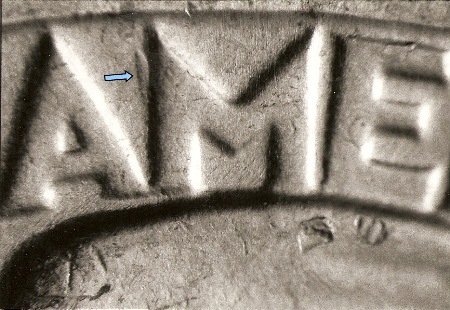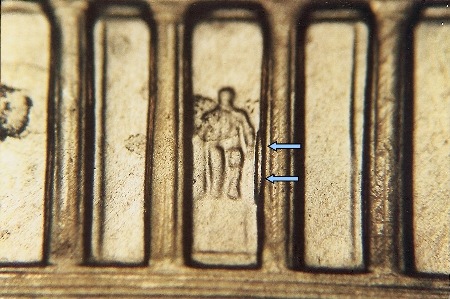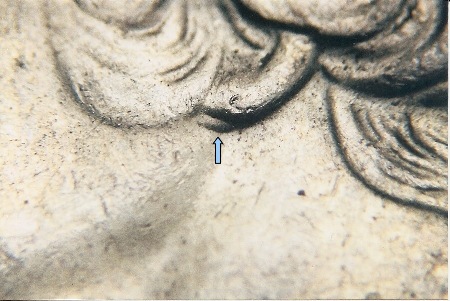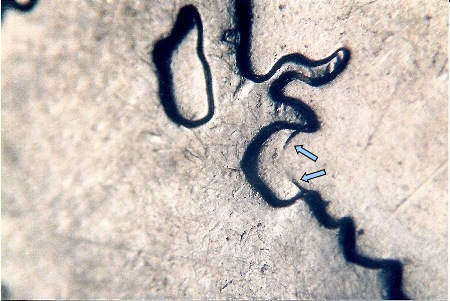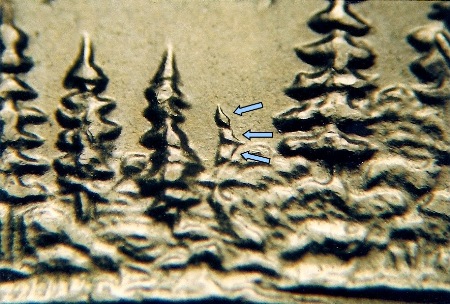


 |
 |
 |
 |
 |
 |
 |
 |
 |
 |
 |
 |
 |
 |
 |
 |
 |
 |
 |
 |
 |
 |
 |
 |
The final class of doubled dies is the Class VIII “tilted hub doubling” varieties. They are the result of a tilted hub in the hubbing press. This class of doubled die varieties will be examined for both the multiple-squeeze hubbing era and the single-squeeze hubbing era, as the doubling found on this class of doubled die varieties is quite different for each of those eras. During the multiple-squeeze hubbing era the working hub was locked into the top of the hubbing chamber for the first hubbing. As a result, if the hub was in a slightly tilted orientation while in that locked position, it was highly unlikely that it would move into proper alignment during the hubbing and would most likely finish that first hubbing in the tilted position. One side of the hub would penetrate more deeply into the die than the other during the hubbing with the tilted hub. Because of the tilted orientation of the hub, when the initial hubbing was completed the side of the tilted hub that was slightly further downward would be drawn slightly towards the center of the die. When subsequent hubbings were made, the working hub was not locked into the top of the hubbing chamber. Rather, it rested on the top of the working die, and as a result was most likely in a normal orientation and not tilted. The properly oriented design would be slightly closer to the rim than the original impression in the area where the tilted impression was pulled inward. These misaligned images would show as doubling spread towards the rim (stronger image towards the rim and weaker image towards the center).
Here we see the doubling on the 1964 Lincoln cent doubled die that we have listed as 1964 1¢ WDDO-007. Notice how the doubling on the letters of IN are spread towards the rim. The variety also shows a CCW spread to the doubling.
This is the doubling seen on the Class VIII 1963 Washington Quarter doubled die reverse that we have listed as 1963 25¢ WDDR-006. Once again notice how the weaker impression is spread towards the center while the stronger impression is spread towards the rim. A close CW spread to the doubling is also apparent. We believe that it was also possible for the working die to receive a “normal” first impression, and then have the working hub tilted for the second or later hubbings due to debris in the alignment grooves that prevented the lugs from sitting properly. In this case the stronger impression would be the one pulled toward the center of the die from the tilt. Here we would describe the doubling as being spread towards the center (weaker image towards the rim and stronger image towards the center). While this scenario seems possible, the first scenario was the more likely. Since Class VIII doubled die varieties during the multiple-squeeze hubbing era display spreads that are either towards the rim or possibly towards the center, it may be necessary to reexamine previously listed Class II doubled die varieties. Class II doubled die varieties also have spreads that are either towards the rim or towards the center. Some of those doubled die varieties listed as Class II varieties may actually be Class VIII varieties, especially if the doubling exists on a limited area of the obverse or reverse (just the top or just the bottom, just the left side or just the right side). The Class VIII varieties from the multiple-squeeze hubbing era will have a strongest point of doubling and then, as you move away from that point in both directions around the rim (CW or CCW), the doubling will start to diminish. Most of the listed Class VIII doubled die varieties listed from this era were attributed as such only because they also display a Class I rotation or a Class V pivot which also pulled the doubling in a CW or CCW direction. Had it not been for the additional CW or CCW spread, they may have been attributed as Class II varieties. 1964 1¢ WDDO-007 illustrated earlier shows a CCW spread in addition to the spread towards the center. It is actually as Class V + VIII variety. Likewise, 1963 25¢ WDDR-006 shows a slight CW spread in addition to the spread towards the center and is also a Class V + VIII variety. When the Mint switched to the single-squeeze hubbing process, the hub and die set-up in the hubbing press changed for the first hubbing which now would be the only hubbing. The hub is no longer locked into the top of the hubbing chamber. The die blank is placed into the well of a collar placed in the bottom of the coining chamber. The hub is also placed into the well of the collar so that the face of the hub is resting on the conical point of the top of the die blank. Since the diameter of the well in the collar has to exceed the diameter of the die blank and the hub (so that the die blank and hub can be inserted into and removed from the collar, and so that the hub can be pushed downward into the die), there is “play” in the collar well. It allows for some horizontal movement between the hub and the die when the hubbing process begins. There is even the possibility of some rotational movement. More importantly for this discussion, the hub will be tilted with respect to the die prior to the start of the hubbing since it is sitting unrestrained on point of the cone of the die blank in the collar well. Since the hub is slightly tilted at the time the hubbing begins, as it is pushed down into the collar well and into the die blank, the flat top of the hubbing chamber pushing against the flat bottom of the working hub will force the working hub into a more vertical alignment in the collar well. Since the face of the die blank is cone-shaped and the design elements on the hub are raised, there is likely to be some movement (slipping of the tip of the cone off of the centralized raised design element after a slight impression has been made), and minor doubling will occur to some part of the design at the center of the die. Because the hub is not fixed to the top of the hubbing chamber as it was in the multiple-squeeze hubbing presses, the movements resulting from the “play” in the well of the hubbing chamber seem to occur frequently producing an abundance of minor Class VIII doubled die varieties.
Some doubling shows on the lower left side of the 7th Memorial column on the Class VIII doubled die reverse that we have listed as 1999 1¢ WDDR-045. The area around the statue of Lincoln on the reverse of the Lincoln Memorial cents is the “target area” for Class VIII doubled dies produced on the singe-squeeze hubbing presses.
The lower part of Washington’s ear is at the center of the die and thus is in the target area for Class VIII doubled dies produced on the single-squeeze hubbing presses. Here we see a doubled earlobe on a 2002-D Ohio State quarter listed as 2002-D 25¢ OH WDDO-001. Similar varieties exist for many of the other states in the Statehood Quarter series.
On the reverse of the Wyoming State quarters the horse’s saddle horn is near the center of the die and is thus in the target area for Class VIII doubled dies produced on the single-squeeze hubbing presses. Here we see doubling to the lower part of the saddle horn and the horse’s mane directly below the saddle horn on the doubled die that we have listed as 2007-P 25¢ WY WDDR-024. If there is some resistance to the vertical realignment when the hubbing begins, it may snap back into proper alignment at a later point in time as the hubbing proceeds. Hubbing press operators have described a “clunking sound” that is heard when the hub snaps back into proper alignment. When this happens, there will be a stronger misalignment between the image formed prior to the hub snapping into alignment and the image formed after the snap. The result is doubling that is stronger and more widespread, but still confined to a centralized area.
Strong doubling shows on the left side of the lower 7th Memorial column on the reverse of the 2004 Class VIII Lincoln cent doubled die that we have listed as 2004 1¢ WDDR-027. Extra knees can be seen to the left of the normal knees and an extra leg can be seen between the lower part of the two normal legs. The amount and strength of the doubled image suggests that the hub resisted moving back into a normal vertical alignment at the start of the hubbing and snapped back into alignment as the hubbing progressed.
This strong “extra tree” can be found on the Minnesota State quarter doubled die reverse that we have listed as 2005-P 25¢ MN WDDR-002. On these quarters the area around the 3rd complete tree to the right of the state outline is the target area for doubled dies produced on these quarters. Once again the hub most likely resisted moving back into a normal vertical alignment at the start of the hubbing and snapped back into alignment as the hubbing progressed.
The log ends to the left of the small window are in the Class VIII target area for doubled dies on the reverse of the 2009 Early Childhood Lincoln cents. On the variety that we have listed as 2009 1¢ EC WDDR-014 four extra log ends can be found to the right of the normal log ends. Here again it is likely that the hub initially resisted moving into proper vertical alignment at the start of the hubbing.
A very strong extra finger can be found on the reverse of the 2009 Formative Years Lincoln cent that we have listed as 2009 1¢ FY WDDR-001. The hand holding the book is at the center of the reverse design for these cents. As you search the more recent coinage for doubled dies, it is still important to search the entire obverse or the entire reverse for doubling. Other movements in the single-squeeze hubbing press collar wells are possible that may produce doubling to other parts of the design outside the Class VIII target area. By switching to the single-squeeze hubbing presses the Mint had hoped to eliminate, or at least greatly reduce, the doubled die error. However, because of the set-up between the hub and die in the single-squeeze hubbing presses, minor doubled dies seem to be more prevalent than ever and the vast majority of them are Class VIII doubled die varieties. Go To: | ||




